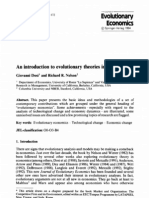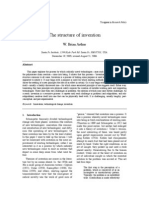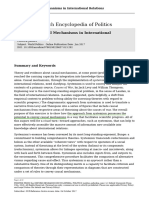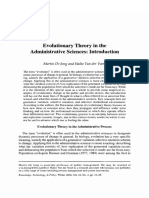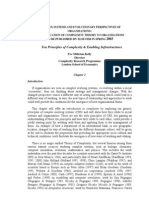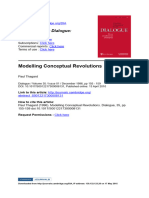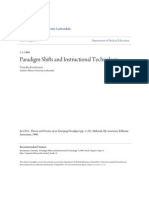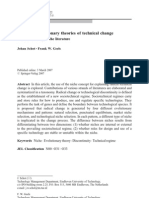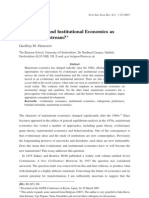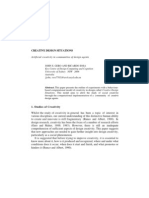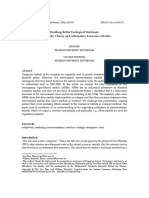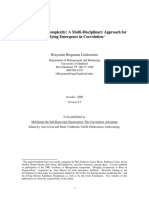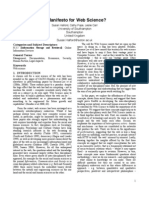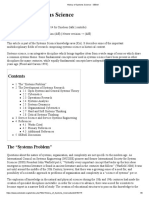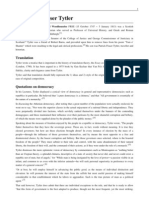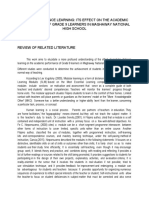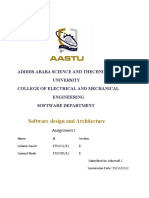Evolution As Computation: Implications For Economic Theory and Ontology
Evolution As Computation: Implications For Economic Theory and Ontology
Uploaded by
sbr9guyCopyright:
Available Formats
Evolution As Computation: Implications For Economic Theory and Ontology
Evolution As Computation: Implications For Economic Theory and Ontology
Uploaded by
sbr9guyOriginal Title
Copyright
Available Formats
Share this document
Did you find this document useful?
Is this content inappropriate?
Copyright:
Available Formats
Evolution As Computation: Implications For Economic Theory and Ontology
Evolution As Computation: Implications For Economic Theory and Ontology
Uploaded by
sbr9guyCopyright:
Available Formats
Evolution as Computation: Implications for Economic Theory and Ontology
Eric D. Beinhocker
SFI WORKING PAPER: 2010-12-037
SFI Working Papers contain accounts of scientific work of the author(s) and do not necessarily represent the views of the Santa Fe Institute. We accept papers intended for publication in peer-reviewed journals or proceedings volumes, but not papers that have already appeared in print. Except for papers by our external faculty, papers must be based on work done at SFI, inspired by an invited visit to or collaboration at SFI, or funded by an SFI grant. NOTICE: This working paper is included by permission of the contributing author(s) as a means to ensure timely distribution of the scholarly and technical work on a non-commercial basis. Copyright and all rights therein are maintained by the author(s). It is understood that all persons copying this information will adhere to the terms and constraints invoked by each author's copyright. These works may be reposted only with the explicit permission of the copyright holder. www.santafe.edu
SANTA FE INSTITUTE
Draft submitted 29 Oct 2010 to the Journal of Institutional Economics, accepted subject to revisions for the special issue on evolution and institutions
Evolution as Computation: Implications for Economic Theory and Ontology
Eric D. Beinhocker1 McKinsey Global Institute, London UK
Abstract: During the past few decades, work by evolutionary theorists and others on evolution as a form of computation has yielded important insights in fields ranging from biology, to computer science, information theory, and physics. Yet this research stream has had relatively little impact on evolutionary views of the economy and institutions. This paper argues that this literature offers the potential for advances in the theory and ontology of evolutionary and institutional economics. The paper explores how the computational concept of algorithmic search through a design space may help unify notions of technological, institutional, and economic evolution and explain processes of order and complexity creation in the economy. It further shows how computational concepts may strengthen ontological foundations by integrating generalized Darwinism and the continuity hypothesis. Finally, the article suggests avenues for future research. JEL: A12, B41, B52, D83 Keywords: evolutionary economics, institutional economics, universal Darwinism, algorithmic search, ontology, complex systems.
1. INTRODUCTION
The study of evolutionary theories of change in economies and institutions has long been interdisciplinary. Nelson and Winters (1982) work drew on economics, organization theory, and made pioneering use of computer simulations. Hodgsons (2004) historical survey shows a field drawing from evolutionary theory, sociology, history, philosophy, and many other influences. North (2005) integrates institutional theory, cognitive theory, complexity theory, and evolution. And Ostrom (2007) looks to a future that
1 eric.beinhocker@mckinsey.com
Beinhocker, JOIE draft 29/10/10
incorporates behavioral economics, behavioral game theory, and experimental economics into the broad church of theories and methodologies employed. This paper will argue, that there is a further stream of research that can make a powerful contribution to evolutionary theories of economies and institutions. That stream, referred to in this paper as evolution as computation, is in itself interdisciplinary, cutting across biological evolutionary theory, theories of computation, mathematics, information theory, and physics. The potential contributions that evolution as computation might make to theories of economic and institutional evolution include a deeper understanding of the evolutionary process itself, and a common framework for understanding the relationship between institutional evolution, technology evolution, and economic system evolution. Furthermore, such a perspective may offer a new view on recent debates on the ontological foundations of evolutionary change in socio-economic systems and strengthen those ontological foundations. Finally, it offers a new toolbox of analytical, computational, and conceptual methodologies for researchers to draw on. In section 2 I give a brief overview of the development of the evolution as computation research program, and in section 3 I provide a high-level outline of some of the core ideas. Then in section 4 I sketch out how the evolution as computation perspective might be applied to institutional and technological evolution and co-evolution, and in particular how the concept of evolutionary search through design space might provide a useful integrating framework. Section 5 explores how such a mapping of evolution as computation onto economic evolution might explain key patterns in economic development. Section 6 then briefly discusses ontological implications, in particular regarding debates on generalized Darwinism versus the continuity hypothesis. Finally section 7 offers conclusions and directions for future research.
2. EVOLUTION AS COMPUTATION (1932 2010)
In his influential 1932 paper, the geneticist Sewell Wright, wrestled with the combinatorial problem of a typical genome with 1000 genetic loci with 10 different allelomorphs each, together yielding 101000 possible genetic combinations a number vastly larger than the estimated number of particles in the universe. How does the evolutionary process explore such a staggeringly large space of possibility? How does it find within that staggeringly large space the almost infinitesimally small fraction of combinations that could potentially yield coherent, functional designs for organisms? To analyze this problem, Wright proposed a theoretical construct whereby each point in the genetic combinatorial set is assigned a value for its adaptiveness as Wright described it. This could then be visualized as a two dimensional surface, later described as a fitness landscape (Dennett, 1995),
Evolution as Computation: Implications for Economic Theory and Ontology
with peaks and valleys reflecting the environmental fitness of particular genomic combinations. Evolutions job then was to search that landscape for fit genomic combinations. Initially Wrights paper was viewed as a modest methodological advance, only later did it come to be appreciated as a major re-conception of what evolution is and does. By framing evolution as a process of search through a combinatorial space of possibilities, Wright put evolution into a realm very familiar to mathematicians, and later, computer scientists. To these researchers, the problem of evolutionary search across a fitness landscape looked like a form of optimization problem, where evolution was a process of search for maxima in a dynamically changing, high dimensional space. Mathematically, the fitness landscape problem shared features with multidimension function optimization problems, combinatorial optimization problems, Hamilton Path problems, Hopfield networks, map coloring problems, energy minimization, and spin-glass problems in physics (Kauffman 1993, Flake 1998). These similarities were not merely coincidental as all of these problems either are, or have the potential to be, what mathematicians call NP-complete or NP-hard problems (Karp, 1972) that is the time it takes any known algorithm to find a solution to the problem or locate a global optima rises rapidly with the size of the problem. The classic example is the Hamilton Path or travelling salesman problem where the problem is to find the shortest itinerary for a salesman travelling through n cities, stopping in each city once, and beginning and ending in the same city. A 5 city tour has 12 possible solutions, a 10 city tour has 181,440 possible solutions, and a 15 city tour 4.36 x 1010 solutions. Thus Wrights paper put evolution in the same mathematical family as these difficult search problems. This led to attempts to use computers to algorithmically evolutionary search and DeJong (2006) cites Friedman (1956) and Friedberg (1959) as the two earliest instances of evolutionary computation. This then led to pioneering work in the 1960s and 70s by figures such as Rechenberg (1965), Fogel et. al. (1966), and Holland (1962, 1967, 1975) and the birth of the field of evolutionary computation. A broad literature developed on genetic algorithms, genetic programming, artificial life, and related methods, with applications ranging from communications routing, to circuit design, drug design, stock picking, machine learning, and artificial intelligence (see Koza 1992, Levy 1992, Whitley 1993, Mitchell 1996, and DeJong 2006 for examples). Within this literature, Darwinian approaches to evolution were simulated and analyzed, but viewed merely as one branch of a family tree of possible evolutionary search algorithms that also included simulated annealing, various hill climbing approaches, and wide variety of genetic algorithms.
Beinhocker, JOIE draft 29/10/10
Initially the field was concerned with developing algorithms and programming techniques inspired by biological evolution for the purposes of finding good solutions to difficult search and optimization problems. But another branch of the field began to consider the possibility that if evolution was able to be simulated on computers, then in a deep sense, following the work of Turing (1931), evolution itself was a form of computation. Hollands (1975) book provided a formal framework for unifying a computational view of evolution across both natural and artificial systems. In the 1980s and 90s the computational view of evolution began to be connected with emerging work on complex systems, and self-organization (Kauffman, 1993), as well as rooted in fundamental work on dissipative thermodynamic systems by figures such as Erwin Schrdenger (1944) and Ilya Prigogine (1967), as well as von Neumans (1966) work on self-replicating systems and cellular automata, and the physics of information (Percus, Istrate, and Moore 2006, Bais and Farmer, 2007). This led to a further interpretation of evolution as a bootstrapping algorithm that uses free energy to create order in complex systems. Over the past decade, this computational perspective began to link with mathematical work on the dynamics of evolutionary systems and the modern neo-Darwinian synthesis, to create an abstract theoretic, computational, and analytic framework that in the 1980s and 90s began to be applied back to biological evolutionary systems. Landweber and Winfree (1999), Crutchfield and Schuster (2003), and Nowak (2006) provide examples of applications of evolution as computation in natural systems. This work has led to productive insights on topics ranging from macroevolutionary dynamics, to speciation, mutation, punctuated equilibrium, evolutionary drift, genome architecture, and even attempts at predictive biology. Computational approaches to evolution have also had some impact on the study of socio-economic systems, primarily through the use of genetic algorithms as a method for simulating agent behavior and strategy search. Genetic algorithms were first applied in this context in the late 1980s by Brian Arthur, John Holland and their collaborators with the Santa Fe Artificial Stock Market (Arthur, 1995, Arthur et. al. 1997). Since then, genetic algorithms have been applied in a wide number of agent-based models (Tesfatsion and Judd, 2006, Epstein, 2006), game theory models (Lindgren and Nordahl, 1994), and other economic applications such as data mining for finance (Bauer, 1994). While this work has been methodologically interesting, there has been no general attempt to apply computational theories of evolution to theories and ontologies of economic and institutional evolution. Searches of the main journals publishing evolutionary economic and institutional work yielded no hits for foundational citations in the evolution as computation literature (e.g. Holland, 1975), and very few hits for terms such as evolution + computation
Evolution as Computation: Implications for Economic Theory and Ontology
and evolution + algorithm, and those found generally addressed the use of computational techniques in modeling (e.g. Safarzynska and Bergh, 2009) and not the theoretical or ontological implications.2 Frenken (2006a and 2006b) explores the implications of evolution as computation for technology evolution and addresses organizational evolution, but does not attempt a broader link to theories of economic evolution. Potts (2000) work on microeconomic foundations of evolutionary economics touches on many of the themes raised by evolution and computation, in particular the evolution of complexity, and cites some of the literature, but he does not frame his theory in computational terms. Nor do recent survey volumes (e.g. Witt, 2008, Hannappi and Elsner, 2008) grapple with this perspective. The remainder of this paper will attempt to fill that gap.
3. ALGORITHMIC SEARCH AND THE CREATION OF ORDER
The evolution as computation view starts with neither biology, nor a broad view of biology and culture. Rather it starts with a perspective that evolution is a form of computation. We can begin with the notion that evolutionary processes are algorithmic processes, an idea that is by now well established in both evolutionary and computational theory (Holland 1975, Dennett 1995, Landweber and Winfree 1999) and firmly locates evolutionary theory within the theory of computation. 3.1 Evolution as algorithm An algorithm can be defined as a process that takes some set of inputs, manipulates those inputs in a sequence of steps according to a set of rules, and then produces a set of outputs. A baking recipe for example fits this definition (e.g. input flour, eggs, butter, sugar, baking powder; stir together well; bake at 175 degrees Celsius for 30 minutes; allow to cool; then output one cake). Dennett (1995) uses the example of a tennis tournament where one inputs players, grinds them through a set of rules for advancing to quarter finals, semi-finals, etc., and then outputs a result: the winner. But as Dennett notes, a tournament process is a fairly generic kind of algorithm, it can be used equally well for golf, soccer, or tiddlywinks, as it can for tennis. Dennett refers to such algorithms as substrate-neutral as the algorithm can run in a variety of environments and operate on a variety of types of inputs what defines the algorithm is the rule-set inside it, not the particular substrate it works in. A computer software program is an example of a substrate-neutral algorithm.
2 The journals searched were the Journal of Institutional Economics, the Journal of Evolutionary Economics, and the Journal of Economic Methodology.
Beinhocker, JOIE draft 29/10/10
The link to computation comes from the pioneering work of Alan Turing (1936) who formally defined algorithms and the notion of a universal computer (sometimes referred to as a Turing machine). In essence Turing created a general theory of computation that does not need to run on what we conventionally think of as a computer. While in practice it may be difficult to get Microsoft Word to run on anything other than your laptop, it is not impossible for example, in the 1980s a group of MIT students built a digital computer out of Tinkertoys that played tic-tac-toe, though it was the size of several refrigerators and not very fast. It has also been shown that biological DNA is a substrate that computes in a literal, Turing sense. Adleman (1994) is the first example of an experiment where DNA molecules were artificially programmed to compute, solving a seven city Hamilton Path problem and doing so extremely efficiently. One can likewise think of biological evolution as a computational algorithmic process that runs on the substrate of DNA and the other chemical machinery of biological organisms, but evolution itself is a more general substrate-neutral algorithm. Indeed there is a large literature of researchers exploring the computational properties of evolution abstracted from its biological instantiation (e.g. Holland 1975, Koza 1992, Mitchell 1996, Landweber and Winfree, 2002, Crutchfield and Schuster, 2003, Nowak, 2006). If we thus classify evolution as a member of the general class algorithms that can run on any Turing machine, it then follows to ask what kind of algorithm it is? There are many kinds of algorithmic processes optimization algorithms, compression algorithms, error correction algorithms and so on. Following Wright (1932) and the subsequent literature, evolution can be characterized as a form of search algorithm that recursively explores a combinatorial problem space seeking out solutions that are more fit than others according to some notion of fitness (a concept we will return to). Evolution is not the only form of search algorithm (e.g. matching routines for searching databases), nor is it the only algorithm that iteratively searches combinatorial problem spaces across a fitness surface (e.g. hill-climbing and simulated annealing algorithms). Rather we can identify it as a particular form of search algorithm that uses the Darwinian operators of variation, selection, and replication to search a design or problem space as discussed in the next section. 3.2 Searching design space What distinguishes evolutionary algorithms from other search algorithms are the characteristics of the problem space they search, and the method by which they search them. Dennett (1995) characterizes evolution as an algorithm suited for finding fit designs. A design has a purpose, e.g. the purpose of
Evolution as Computation: Implications for Economic Theory and Ontology
the design for a chair is to comfortably support a human being in a sitting position. One can also think of a design as solving a problem, e.g. the design of an Eames chair is a candidate solution to the problem of comfortably supporting a human in a sitting position. As long as there is a variety of candidate designs, some designs will inevitable by more fit for purpose or solve the problem better than other designs. An Eames chair might for example be perceived by a user as more comfortable and more attractive than an alternative chair design and thus more fit for purpose and a better solution to the sitting problem. While purpose of human designs is then to fulfill human needs (Georgescu-Roegen, 1971), the purpose of designs created by biological evolution is simple to survive and reproduce in their environment. There are a near infinite variety of possible designs that fulfill this purpose, ranging from a bacterium to an elephant. But as Dawkins (1976) points out, any biological design that did not fulfill this purpose would by definition disappear. Another way to think of it is that a tree frog is a candidate solution to the problem of surviving and reproducing in its particular environment, and its very existence is ipso facto proof that it was a successful solution to that problem at a point in time. For any design there are variants of that design that may be better or worse at fulfilling the designs purpose or solving the problem. What constitutes better or worse is referred to as the fitness function and may contain any number of dimensions. For example the fitness function for the design of a chair might include dimensions of comfort, attractiveness, cost, durability, and so on, while the fitness dimensions of a tree frog might include metabolic efficiency, hopping distance, effectiveness of camouflage, and so on. The source of the fitness function is the environment into which the design is physically rendered. A design variant for a tree frog might be rendered into a rainforest environment of food sources, predators, habitats, etc. that shape its fitness function. A design variant for a chair might be rendered into an environment of people sitting on it, deciding whether they like it or not, whether to buy it or not, whether to use it or not, and so on. Fitness functions are dynamic and change over time as the environment changes, and there is dynamic feedback or co-evolution between designs and the fitness function generated by their environment. In the computational conception of evolution it is important to conceptually separate the design of a thing from the thing itself (what Dopfer and Potts, 2004, call the first axiom of evolutionary realism all existences are bimodal matter-energy actualizations of ideas). A design exists as information while a rendering of the design exists in a physical environment. For example the information for the design of a chair might be captured in a blueprint and a set of instructions for making the chair such encoding of design information can be referred to as a schema (Holland 1975, 1995,
Beinhocker, JOIE draft 29/10/10
Mitchell, 1996). A chair itself is then a physical rendering of the design encapsulated by the schema. And while all physically rendered designs are actualizations of ideas, it does not follow that all ideas or possible schema are or can be actualized. The set of chair designs that can possibly be physically rendered under the laws of physics is a subset of the set of all possible chair designs. The set of physical instantiations of chair designs that will ever be rendered in the lifetime of the universe is then a further subset of that. This definition applies not just to artifacts but to other forms of design as well. The design for a shiatsu massage can be encoded in a set of instructions and then rendered by someone providing such a massage. We can even make this separation between schema and physical rendering for things that are purely information themselves. For example one can create a schema for a possible computer code, but until it is run on some sort of Turing machine (which is subject to the laws of thermodynamics) it cannot be considered to be physically rendered. The physical rendering of a design into an environment is sometimes referred to as an interactor (Hull, 1988). It is the physical rendering of the design that interacts with the environment and is subject to fitness pressures, not the design itself (though this is not to imply that the unit of selection is the interactor itself, units of selection tend to be modules of design within schema). Interactors can be composed of matter and energy (e.g. an organism in biology) or can be information themselves (e.g. in a genetic algorithm the schema may code for a bit string that is then subject to selection pressures this is a physical rendering as well because the computational operations require energy). The process of translating from the information world of design encoded in schema into the physical world of interactors is an often overlooked aspect of evolution, but it shapes important characteristics of the process. In order for a design to be rendered there must be a schema-reader/interactor-builder to do the rendering (for simplicity Ill refer this concept as a reader/builder). In the biological world, for mammals the reader/builder is a female womb, for birds, fish, and amphibians it is an egg both render from the schema of DNA into an interactor organism. For a chair the reader/builder might be a carpenter, for a shiatsu massage it might be a masseuse. The need for a reader/builder has two important implications: First, the schema does not have to capture all of the information in the design, only enough so that the design can be reliably rendered by the reader/builder. The design for a chair has to only be detailed enough for a qualified carpenter with the right tools and materials to build it. The design for a mouse encoded in mouse DNA only has to be sufficient to be rendered by a female mouse womb into a baby mouse. This implies significant knowledge and design in the reader/builder, and one can then ask where this
Evolution as Computation: Implications for Economic Theory and Ontology
knowledge and design comes from. The answer of course is that reader/builders are the result of evolutionary processes themselves. In biology schema code for interactors who also serve as reader/builders (the reading and building is part of the design), giving biological evolution its bootstrapping character. In other substrates, the reader/builder may be the product of multiple evolutionary processes, e.g. the carpenters ability to serve as a reader/builder for chairs may be the product of evolution across biological, technological, and social substrates. We will discuss the role of reader/builders in economic, technological, and social substrates further in Section 4. Second, as reader/builders must exist in the physical world, they are subject to physical constraints. This means, as mentioned previously, that there are designs that cannot be built. There are chair designs that violate the laws of physics, or cannot be built with the knowledge and technology of the reader/builder that exist at a point in time. Likewise, there are DNA variants for a mouse that cannot be built and will be miscarried by the female mouses womb. This means that while the space of renderable chair and mouse designs may be astronomically large, it is nonetheless finite (Beinhocker, 2006, pp. 233-235). The bounds of this finite space may change over time, however. As technology changes, the space of possible chair designs the carpenter can render may also change. As the designs for female mice evolve, what their wombs can and cannot render will also shift.3 The total set of renderable designs can be referred to as a design space. The size of a design space depends on two factors: the number of modules or dimensions that the design can be varied on, and the number of possible variants for each of those modules or dimensions. Design tends to be characterized by modularity (Holland 1995, Arthur 2009) with modules and sub-modules, and sub-sub modules. E.g. a chair has arms, and the arms in turn might be made of various pieces of wood, metal, or material. The number of possible variants of a design rises exponentially with the number of modules, sub-modules, etc. and number of possible variants on each of those components. Thus the number of possible variants of even a simple design tends to be very large. For designs of even modest complexity the number of possible designs, though finite, exceeds the number of particles in the universe (Dennett, 1995). Thus for most design spaces, only a very small subset of possible designs will ever be rendered. The number of chairs ever built will be infinitesimally small versus the number of possibilities.
3 While the bounds of a space of renderable designs may grow over time, the space can never become infinite due to basic physical limits on information processing. The schema itself must be finite (no female mouse womb could process an infinitely long piece of DNA in finite time), and therefore the number of possible schema variants encoded in any computable language must also be finite (Beinhocker, 2006, pp. 233-235).
Beinhocker, JOIE draft 29/10/10
What the algorithm of evolution is particularly good at is searching such almost-infinite spaces of possible designs for designs that are fit for their purpose. The operation of the algorithm in this search process is remarkably simple it is the familiar Darwinian mechanism of variation, selection, and replication. A mechanism exists for creating a set of variants on a design and those variants are rendered into physical interactors by reader/builders. The interactors interact with their environment (which includes other interactors), and in the course of those interactions, are subject to selection pressures from the fitness function. There then exists a mechanism for increasing the probability that designs with relatively higher fitness are rendered, and decreasing the probability that designs with relatively lower fitness are rendered. The frequency of relatively fitter designs thus increases in the population of interactors, or alternatively, the share of matter and energy devoted to relatively fitter designs increases (Beinhocker, 2006, p. 291). What the evolutionary algorithm is doing in this process is iteratively sampling sub-sets of design space in a search for relatively fit designs. Mathematically it can be shown that the evolutionary algorithm is particularly good at this sampling process, and adept at finding fit designs in design spaces where the fitness function is rough-correlated (Kauffman, 1993, 1995, pp. 161-189). A fitness function is rough-correlated if small variations from highfitness designs are also likely to have high-fitness, and small variations of lowfitness designs are also likely to have low fitness. If there was a perfect correlation between fitness and variation distance, the design space would have a single global optima and a simple hill-climbing algorithm would find that optima more efficiently than an evolutionary algorithm. In contrast, if there was no correlation, the relationship between fitness and design would be random, and a simple random sampling of the space would outperform evolution. A design space with a rough-correlated fitness function is most effectively searched by a mixture of variation sizes across the dimensions of the fitness function applying small variations on dimensions where there is high fitness (preserving and fine tuning successful design features), but occasionally introducing larger variations to prevent getting stuck on local optima, and applying still larger variations where fitness is low (if a design feature is not working, try something else). A remarkable characteristic of the evolutionary process is that it self-tunes to the shape of a rough-correlated fitness function to find an effective mix of variation distance. This is property of evolution is explored mathematically by Kauffman (1993) in his N-K model, and by Holland (1975, 1995) in the two-armed bandit problem (see Mitchell 1996, pp. 117-125 for a discussion and proof of the two-armed bandit problem). More recent explorations of the mathematical properties of fitness landscapes have yielded some intriguing insights. For example, Crutchfield
10
Evolution as Computation: Implications for Economic Theory and Ontology
(2003, pp. 101-134) attempts to explain key macro features of evolutionary processes, such as metastability, drift, neutral evolution, punctuated equilibrium, and epochal change. He shows how topological features of high dimensional fitness landscapes such as sub-basins of attraction and portals (structures connecting sub-basins) may explain these stylized facts. 3.2 How evolutionary search creates order With evolution viewed as a form of substrate-neutral search algorithm we can then move on to another key point raised by the evolution as computation view evolutionary algorithms are recipes for creating order from disorder, and complexity from simplicity. One of the most striking empirical features of both the biospehere and human society is that each has generated growing order and complexity over time. The arc of biological history extends from the first single-celled prokaryotes to the massive complexity and variety of the Earths biota today. Likewise, the arc of the human history is one of increasing technological and social order and complexity. Human technology has evolved from stone tools to spacecraft, and human institutions from hunter-gatherer troupes to multinational corporations. One measure of this increase in order and complexity is the variety of products and services in the economy. Beinhocker (2006, pp. 8-9) estimates the number of unique products and services in the economy has grown from on the order of 102 circa 15,000 years ago to 1010 today a number higher than many estimates of biological species variety. The increase in order and complexity in both biological and human social systems has not occurred monotonically (i.e. the biosphere has experienced mass extinctions, and human civilizations have collapsed as well as grown), but that it has occurred is beyond doubt. Mainstream neoclassical economics has largely ignored the obvious empirical fact of increasing technological, social, and economic complexity and offers little explanation for it (even so-called endogenous theories of growth, e.g. Romer 1990, locate the process for variety creation outside of economic theory). But a variety of scholars from other traditions have addressed this fact in various ways. Schumpeter (1934) locates the source of novelty and order creation in the acts of the entrepreneur. Hayek wrestled with the question of economic order (1948) and eventually came to explanations of self-organization and evolution (1960, 1973, 1988). However, the two social scientists who have come closest to the evolution as computation perspective on this question are Simon (1996) who examined order in both human artefacts and social structures and proposed an evolutionary process in the interaction of human cognition with the environment as an explanation, and Georgescu-Roegen (1971) who saw the working of an evolutionary algorithm as the only possible explanation for the observed increase in order in the economic system.
11
Beinhocker, JOIE draft 29/10/10
Georgescu-Roegens fundamental insight that the economic process materially consists of the transformation of high entropy to low entropy fits very well with modern understandings of order and evolution. In modern physics, entropy and information are viewed as two sides of the same coin (Haken 2000, Bais and Farmer 2007). As the evolutionary algorithm does its work it reduces informational entropy as it discovers more complex designs over time in the design space, and reduces physical entropy as it uses that information to order matter and energy as the reader/builder renders the design. Evolutionary theorists point out that evolution does not have a direction, but it does have a tendency. As environmental niches fill-up and competition increases in a world where resources are finite at any particular point in time, there is pressure to search new regions of design space, and new regions of design space are opened up by the re-combination of modules into new systems (which then become sub-systems for larger systems) and additions of new functions thus creating designs of growing complexity (Holland 1995, Arthur 2009). Again, the process is not monotonic and as niches collapse there can also be a collapse back towards favoring simpler designs, but the process of niche construction tends to drive the appearance of designs of increasing complexity. The spontaneous, self-organized reduction in physical and social entropy observed in the economy, and the use of energy inputs and creation of waste outputs in that process, are the hallmarks of an evolutionary algorithm at work in fact we know of no other process that produces these results. 3.3 A generic computational view of evolution Abstracting from the evolution as computation literature, we can identify the general set of conditions that a system must have for an evolutionary search algorithm to operate (this set from Beinhocker, 2006, pp. 213-216, Stoelhorst, 2008 provides an alternative but largely compatible set derived from the requirements of causal logic rather than the requirements of computation):
There must be a combinatorial design space of possible designs; It is possible to reliably code and store those designs into a schema; There exists some form of schema reader/builder that can reliably decode
schemata and render them into interactors (schemata may encode for their own reader/builders);
Interactors are rendered into an environment that places constraints on the
interactors (e.g. laws of physics, competition for finite resources); collectively the constraints create a fitness function whereby some interactors are fitter than others;
Interactors collectively form a population;
12
Evolution as Computation: Implications for Economic Theory and Ontology
There is a process of schema variation over time, this can be
accomplished by any number of operators (e.g. crossover, mutation);
There is a process of selection acting on the population over time
whereby less fit interactors have on average a higher probability of being selected for operations of removal from the population;
There is a process of replication whereby more fit interactors have on
average a higher probability than less fit interactors of being selected for operations of replication or amplification;
The combination of these processes operates recursively.
This generic checklist could apply equally well to a genetic algorithm running on a computer, children playing a game with LEGO blocks (Beinhocker, 2006,192-198), biological evolution, or as will be discussed in the next section, human social evolution.
4. EVOLUTIONARY SEARCH IN THE DESIGN SPACES OF THE ECONOMY
The next step then is to ask how this generic, computational perspective might map onto the evolutionary processes of human social systems, specifically economic systems. The purpose of presenting this sketch is not to argue that this is the only such possible mapping. Rather it is to encourage research in this area by demonstrating that such a mapping, however imperfect, is conceptually possible. Following the generic template described in Section 3.3 we first need a design space or spaces. In the following section I propose that there are three design spaces that are relevant to economic evolution: physical technologies, social technologies, and business plans. In Section 4.4 I will describe how the evolutionary algorithm searches those spaces. 4.1 Physical technologies While the term physical technologies is borrowed from Nelson (2003, 2005) and shares its spirit, I offer my own definition which also builds on the notion of techniques in Mokyr (1990, 2000) and Ziman (2000): Physical technologies (PT) are methods and designs for transforming matter, energy, and information from one state into another in pursuit of a goal or goals PTs are the methods and designs for what we commonly think of as technologies, e.g. ox-drawn ploughs, float glass, microchips, Some PTs result in the creation of an artefact (e.g. a stone hand axe) while others result in the
13
Beinhocker, JOIE draft 29/10/10
provision of a service (e.g. the methods and designs for a Shiatsu massage). PTs are encoded in schema via natural language, equations, blueprints, diagrams (all of which can be translated to bit strings) stored in individual minds, documents, computer disks, stone tablets, and so on. These schema are then rendered by reader/builders into physical artefacts and experiences which then become interactors in their environment (e.g. a design for a bridge is turned into a physical bridge by a team of engineers and builders). The PT schema do not need to contain complete descriptions of the methods and designs, but rather just enough information to enable a qualified reader/builder to render the design into the physical environment. Thus an engineer is able to oversee the building of a bridge with the inherently incomplete knowledge contained in blueprints, specifications, in the minds of her colleagues, etc. There is also a process of co-evolution between schema and reader/builder as the engineer experiences more bridge designs her ability to render different parts of the design space will change. This is not unique to human-social evolution, as Dennett (1995) notes and discussed in the previous section, in biology, female eggs and wombs (schema-readers) co-evolve with the DNA (schema) that they read. As with other design spaces, the space of possible PTs is finite at any point in time, but may expand (or shrink) over time as new physical principles are discovered and functionally captured in PTs and variations in currently possible PTs create the potential for newly possible PTs (Arthur, 2009) for example the capture of physical principles that enabled creation of the laser, variations of which then led to the possibility of the CD player, and which variations of which then led to the possibility of the DVD player. By defining PTs as a process of state transformation, we inherently cast PTs in a computational framework. Algorithms are in essence state transformation machines 4.2 Social technologies The second design space is social technologies. Again, the term and spirit are borrowed from Nelson (2003, 2005) but it is useful to define the term specifically for our purposes: Social technologies (STs) are methods and designs for organizing people in pursuit of a goal or goals. Examples of STs might include a hunting party, just-in-time inventory management, or the M-form organization. STs are related to institutions following Norths (1990) definition of institutions as rules of the game but STs are intended to be broader. For example, the STs of a soccer team might include not just the rules of the game, but also the job description of the goalkeeper, the cultural norms of the team, and whether the team fields three
14
Evolution as Computation: Implications for Economic Theory and Ontology
strikers at the front or some other configuration. As with PTs we can imagine schema to encode the methods and designs (e.g. a manual on good soccer team design, strategy diagrams, discussions with experienced players), a larger than the universe design space of all currently possible ST schema, and a qualified schema-reader (e.g. a soccer coach) to render the design into an interactor (e.g. the soccer team) in the environment. Once again, the notion of state transformation is inherent to this definition. The notion of organizing people has implicit in it the transformation from one state of social interactions, relationships, behaviors, and beliefs to another, and a state is deemed more or less organized by its fitness for some purpose. Much of human history can be viewed as a co-evolutionary process between PTs and STs. In both military and scientific history there are numerous examples of innovations in physical technologies leading to innovations in social organization and vice versa. In economic history there is also a strong co-evolutionary interplay between physical and social technologies. For example the physical technologies of the Industrial Revolution inspired social technology innovations in creating large scale factories, and financial markets capable of concentrating large amounts of capital, which in turn spurred further innovations in physical technology. 4.3 Businesses as interactors and business plans as schema PTs and STs can encompass designs in pursuit of a wide range of goals, including political, military, and religious. If our objective is to explain patterns of economic change, it is then useful to describe a third design space that binds PTs and STs together more narrowly in interactors that pursue specifically economic goals. Under this set-up we can define a business as: A business is a person, or an organized group of people, who transform(s) matter, energy, and information from one state into another with the goal of making a profit. Businesses as defined in this way serve as the interactors in the economic system (Hodgson and Knudsen, 2006). Though Ive used the term business rather than Hodgson and Knudsen and others use of the term firms to allow for the fact that firms may be supersets of businesses in the above definition. We can then think of business plans (BPs) as schema that code for the designs of businesses, e.g. IBM can be said to have a business plan which codes for the design of its business (similar in spirit to Hannan and Freemans 1977 organizational blueprint). Again, a business plan does not have to be a complete description, nor even written down all in one place, as long as a business plan reader/builder (e.g. IBMs management team) can access the necessary information to render the design of IBM into the environment. And
15
Beinhocker, JOIE draft 29/10/10
as with PT and ST design space we can have a larger than the universe design space of business plans that includes all possible variants on IBM and every other business, and in which some of those variants are fitter than others at a given point in time. Economic evolution is then a process of co-evolutionary search through these three design spaces. As new PTs and STs are discovered and rendered they are combined and re-combined into new business plans which are rendered into businesses, whose activities then change the PT and ST fitness function, leading to changes in the business plan fitness function and so on, creating a co-evolutionary dynamic. 4.4 Evolutionary search by deductive-tinkering We can then ask how the evolutionary search process proceeds in these three co-evolving design spaces. Building on Campbells (1960) and Simons (1996) work on the role of cognition in human social evolution, one can make a relatively simple proposal. People pursue goals when searching PT, ST, and BP space a better mousetrap, a better soccer team, or a better IBM. But it is not possible to deductively determine what would constitute a better mousetrap, soccer team, or IBM from first principles. The space of possibilities is too vast, the interactors themselves are too complex, their interactions with their environment are too complex, and the fitness function may only be partially known. Human designers searching these design spaces are then left with no choice. They can use their powers of logic and deduction for as far as they will take them, but then at some point they need to try things, tinker and experiment, get feedback from the environment, and try again. There is a significant computational economics literature (e.g. Lewis 1985, 1956, Vellupilai 2005) showing the impossibility of approaching such problems from a purely rational deductive standpoint (which in turn provides a powerful critique of neoclassical theory). Vincentis (1994) study of the development of retractable aircraft landing gear provides an example where the engineers and manufacturers involved make their best efforts at deductively creating new landing gear designs from scientific and engineering principles, but run into the limits of that approach and also engage in substantial experimentation or tinkering with existing designs. I refer to this process of combining deductive insight with tinkering experimentation as deductive-tinkering. It is the deductive-tinkering process of human designers that provides the source of variation in the three economic design spaces. The process of deductive-tinkering creates options and choices in the design process, e.g. Design A when rendered performed very well in the environment, I could try to improve it by making variations B or C.
16
Evolution as Computation: Implications for Economic Theory and Ontology
Competition amongst designs for finite resources at any point in time then provides selection pressures (e.g. functional performance, consumer preferences, costs), and choices are then made as to where those resources are allocated, thus providing amplification to higher fitness designs and deamplifying less fit designs, i.e. more fit designs generally get more money, talent, energy, materials, and so on over time. The process of deductivetinkering can occur at multiple levels in the economic system. It can occur in the head of a single individual (e.g. an inventor searching PT space or an entrepreneur searching BP space), or it can be a group process (e.g. a technology design team, or a management team). It can also include groups arranged across organizational hierarchies (e.g. the regional office generates 10 potential variants on its current business plan, selects 3 as promising and proposes those to the national office which turns the 3 into 5, proposes them to the global office, etc.). It is important to note that there is nothing in our generic picture of evolution as a form of search algorithm in Section 3 that says that the process of variation has to be random, or that the process of search cannot involve foresight or intentionality. The question of the role of intentionality and foresight in human systems, versus the random-blind nature of biological system has long been a point of debate in efforts to incorporate evolution in social theory. The evolution as computation perspective addresses this issue in a simple way. All the evolutionary algorithm requires is some process of variety creation that samples the design space that sampling process may differ significantly in different domains. As PTs, STs, and BPs, are all defined as designs for transformation processes in pursuit of a goal, the evolutionary search through their design space quite naturally leads to a result of decreasing local entropy. Taking again Vincentis (1994) case of retractable aircraft landing gear, we can see manufacturing such gear as involving the transformation of disordered raw materials through a series of steps into the ordered artefact of landing gear (using energy to go from high entropy to low entropy). The deductivetinkering search for better landing gear led over time to a progression from simple wheels affixed to wings designs in the 1920s, to the highly complex and sophisticated retractable landing gear of a modern jumbo jet today. One can say that as the fitness function changed (bigger, heavier, faster planes required different landing gear), it drove the deductive-tinkering process to create new landing gear variants, and select and amplify certain designs based on their performance. The result was landing gear designs that are arguably more ordered and lower entropy today than the design in the 1920s (this can be tested by measuring the length of maximally compressed bit string required to describe each design or in intuitive terms the blueprints for a 1920s landing gear would be simpler and take fewer pages than the blueprints for
17
Beinhocker, JOIE draft 29/10/10
modern 747 landing gear). Thus in the process of evolutionary search through PT, ST, and BP design spaces we can see the potential for local entropy reduction over time. Finally, it should be noted that certain inventions can have meta effects on the economic evolutionary process itself. For example, social technology inventions such as organized markets, money, and double-entry accounting, or physical technology inventions such as the printing press, telephone, or computer, have helped increase the effectiveness and speed of deductivetinkering evolutionary search.
5. EXPLAINING PATTERNS IN THE ECONOMY
Although the description in Section 4 is a bare sketch, one can begin to see how a general computational view of evolution might map onto a theory of economic evolution. Such an exercise holds out the possibility of creating a mathematical or computational model of economic evolution, that because of its relationship to the more general class of evolutionary algorithm, might yield some specific predictions that could be tested (e.g. statistical characteristics of change processes). In principle such a mathematical model or simulation could be developed using the tools of evolutionary computation (Kauffman, 1993, Mitchell, 1997, Landweber and Winfree, 2002, Crutchfield and Schuster, 2003, Nowak, 2006) and the mathematical theory of design (Braha and Maimon 1998, Suh 1990). While there is some debate in evolutionary and institutional economics as to the value of more mathematical approaches (Nelson 2005), one of the historical critiques of evolutionary and institutional economics has been that without a rigorous (i.e. mathematical or computational) articulation of theory, it cannot be tested in the same way that neoclassical theories can be (despite the generally poor performance of neoclassical theory in those tests). This is not to say that an evolution as computation approach to economic evolution would obviate more qualitative, descriptive, case-based, and historical approaches indeed the experience of the study of other complex systems (e.g. biology, climate systems) indicates the two methods are highly complementary. Looking ahead one can posit some hypotheses as to how a program of computational-evolutionary research might contribute to institutional economics: First, literal-computational models of economic evolution might explain the explosive increase in per capita income and product and service variety that resulted from the Industrial Revolution. While the historical narrative of the Industrial Revolution is well known (e.g. Landes, 1969, Clark, 2007), economics offers no satisfactory endogenous theory of this period of dramatic economic change. Neoclassical theory cannot offer such an explanation as the
18
Evolution as Computation: Implications for Economic Theory and Ontology
Industrial Revolution was a profoundly disequilibrium phenomenon. Evolutionary systems, however, can and do undergo such periods of explosive growth in scale, order, variety, and complexity. Mathematical and computational explorations of the evolutionary process locate potential causes of such phenomenon in the shape and structure of fitness landscapes and dynamics of co-evolutionary interactions (Kauffman, 1993, Landweber and Winfree, 2002, Crutchfield and Schuster, 2003). In the case of the Industrial Revolution, analyzing the co-evolutionary dynamics between physical and social technologies would potentially enrich our understanding of the role that institutions played in that transition. Second, new explanations might be found for the distributional patterns of firms (e.g. revenues, numbers of employees, assets) and patterns of firm performance over time (e.g. entries and exits, growth rates, profitability, returns). Again, mathematical and computational research shows that evolutionary processes tend to produce signature distributional patterns, most notably power laws, and these have been found in relation to distributions of various measures of economic and firm performance (e.g. Amaral, et. al., 1997, 1998, Stanley et. al. 1996, Lee et. al. 1998). Axtell (1999, 2001) explores these issues using U.S. census and other data and locates possible explanations in evolutionary dynamics both within firms and between firms. Other researchers have found strong mean regression in firm performance over time, that sustained periods of statistically significant outperformance versus industry mean is rare, suggesting a lack of adaptive behavior at the firm level, and mean industry performance being driven significantly by firm entry and exit (Wiggins and Ruefli 2002, 2005). One hypothesized explanation is a lack of adaptive capacity in firms industries evolve but firms dont. Epstein (2006, pp. 309-343) for example offers a computational-evolutionary model that explores how hierarchical structures and internal trading regimes may impact firm adaptability. Third, taking evolution seriously also requires one to take the Second Law of Thermodynamics seriously as evolution, whether social or biological, occurs in a world of physical constraints. The neoclassical production function and theory of the firm is detached from such physical constraints (Daly, 1999). The flip side of economic order creation driven by the evolutionary process is finite resource use, waste, and pollution, as evidenced by dramatic jumps in all three corresponding with the spread of industrialization. By connecting firms and other institutions to the constraints of the physical world via thermodynamics, an evolution as computation perspective on economic evolution would potentially cause us to re-think the objective functions for those institutions (eventually such physical constraints will become part of the evolutionary fitness function in both economic and biological substrates) and provide normative insights for how we think about
19
Beinhocker, JOIE draft 29/10/10
issues ranging from global warming, to resource productivity, to how we measure performance in economic and political institutions. These are merely examples, but they nonetheless illustrate different ways the evolution as computation view of evolution might contribute to the institutional economics agenda.
6. IMPLICATIONS FOR ONTOLOGY
Over the past decade there has been a vigorous debate on the ontological foundations of evolutionary theories of economics and institutions. The evolution as computation view offers a potential framework for clarifying and integrating some of the perspectives in that debate. For example, Dopfer and Potts (2004) note that critics of evolutionary economics characterize the field as a menagerie of models and studies sui generis. They argue for a unifying analytical framework and propose three ontological axioms for evolutionary realism: (1) All existences are matterenergy actualizations of ideas (bimodality), (2) all existences associate, and (3) all existences are processes. The evolution as computation view described here would meet all three axioms and potentially go further. Dopfer and Potts note One way [to unify the field] would be to seek unifying mathematical formalisms. This approach has not been much tried in evolutionary economics and mostly because no one, it would seem, really has any idea where to start. An evolution as computation view might provide just such a place to start, and such a program would formally connect the ontological foundations of evolutionary economics to the ontological foundations of thermodynamics, computation, and the physics of information solid ground indeed. One of the most important ontological debates in the literature has been between those advocating a generalized Darwinism (e.g. Nightingale, 2000, Hodgson and Knudsen, 2006, and Aldrich, et. al. 2008) and what is referred to as the continuity hypothesis (e.g. Witt, 2003, Witt, 2004, Cordes, 2006). This is a highly complex and subtle debate, and I will not do it justice here. The generalized Darwinian perspective starts with the perspective that in any population of replicating entities with varying capacities to survive in a complex environment, and where basic physical laws are at work (e.g. entities have finite lives, resources are in finite supply) that the inherent logic of Darwinian evolution will cause it to occur. This is true whether the population is of biological entities or social entities. And while domain and operational details may differ significantly across complex population systems , Darwinian modes of explanation are a necessary (though not sufficient) method for understanding the processes of change in such systems. Proponents of this view further stress that it in no way relies on analogy between biological and social systems. Instead, the logic of Darwinian
20
Evolution as Computation: Implications for Economic Theory and Ontology
evolution provides an ontological link across such systems (Witts monism) and such systems cannot be understood, each in their own right, without appeal to Darwinian logic. The alternative view, the continuity hypothesis, takes as its departure that human beings are the result of Darwinian biological evolution, that this process and the selection pressures it operated under, produced in human brains endowed with certain cognitive capabilities, certain genetically influenced behaviors, and extended the pro-sociality of our primate ancestors to new levels of complexity. As that process of social interaction increased in complexity (and was supported by biological evolution of brains, language capabilities, physical capabilities for toolmaking, etc.), those interactions and the culture that emerged from those interactions began to play an ever larger role in our survival as a species versus strictly biological considerations. And culturally derived and learned behaviors began to increasingly over-ride or modify innate behaviors in many spheres. Culture in turn became increasingly directed at economic activities of food and tool production, and innovations to increase survival, material comfort, mating chances, etc. Such economic activity in turn experienced change processes of innovation, adaptation, imitation, and so on. But while one might call such economic change processes evolutionary they are materially different than biological evolutionary processes and do not share fundamental regularities. Thus, under the continuity hypothesis, while cultural evolution and economic evolution are ontologically connected to biological evolution because they historically emerged from that process, understanding those processes of change requires distinct theories. For example, experimental work shows deep behavioral regularities in social interactions (e.g. Henrich, et. al. 2004) that may have biological evolutionary roots in our primate past, such regularities may in turn provide micro foundations for a theory of cultural evolution (e.g. Boyd and Richerson, 1985, 2005). But such a theory would be domain specific and not necessarily Darwinian, at least in the sense used in biology. The evolution as computation perspective offers potential to bridge the divide between generalized Darwinism and the continuity hypothesis, and by framing the issues in computational terms show that both views are in fact correct. Consistent with generalized Darwinism, the evolution as computation view abstracts the logic of evolutionary processes from the specific domain in which it operates. It would also agree with the generalized Darwinism position that this logic is the only explanation we know of that accounts for key features of complex population systems, including as noted previously the emergence of order and complexity in both biological and social systems. It would also agree that variation, selection, and replication are at the heart of Darwinian logic, but take a very broad view of how that logic can be
21
Beinhocker, JOIE draft 29/10/10
implemented in differing domains (e.g. human intentionality and creativity is a valid source of variation in social domains). A computational view would disagree with one point made by continuity advocates, that abstracting evolutionary logic amounts to nothing more than an attempt to construct an abstract analogy to the domain-specific model of evolutionary biology (Witt, 2004, p. 128). While early attempts to simulate abstract evolutionary processes on computers may have been inspired by biological evolution (DeJong, 2006), as soon as the first evolutionary algorithm ran on the first Turing machine, that abstraction jumped ontological categories beyond analogy to the more universal domain of computation. While Witt is correct in his stance that analogies do not make good theories, analogy as inspiration to discover ontologically sound theories has a long history in science. This is not surprising as analogy-making is a critical part of human cognitive processes for creativity and sense-making (Mitchell, 1993). One can turn the ontological tables and note that the fact that Darwin was inspired by Malthus in developing the theory of natural selection does not position biological evolutionary theory as merely an analogy of economic theory. But this point aside, the computational view can also potentially integrate the continuity program. This is essential, because the major elements of the continuity hypothesis must be prima facie correct most notably there is strong evidence for the co-evolutionary interplay over time between genes, morphology, brains, language, behavior, social structures, artefacts, and environment, extending from our primate ancestors to modern humans (e.g. Cavalli-Sforza, 2001, Jablonka and Lamb, 2005, and Richerson and Boyd, 2005). One path to integration is to note that while the generalized Darwinian logic of variation, selection, and replication lies at the algorithmic heart of the computational process, that the rest of the computational machinery mechanisms for encoding and decoding schema, reader/builders, the emergence of a fitness function, the deductive-tinkering process, and so on requires explanations generating from the continuity hypothesis (in fact, where else could they possibly come from?). The coding of economic schema (PTs, STs, and Business Plans) rely on the evolution of language. Deductivetinkering is an outcome of our cognitive evolution (and may involve geneculture interaction as well). Beinhocker (2006, pp. 308-314) postulates a continuity hypothesis between modern economic preferences and the ancestral evolutionary environment (e.g. our preferences for fatty foods, items signaling status, or economically supporting close genetic kin). Such biologically influenced preferences in turn influence the fitness function at work in Business Plan evolution in the economic system. Much work would need to be done to full explore the ontological implications of the evolution as computation stance, but one can see the
22
Evolution as Computation: Implications for Economic Theory and Ontology
potential to ontologically connect economic evolution at a fundamental level to basic physical laws of thermodynamics, information, and computation, is both analytically and mathematically rigorous, and integrates key elements of both the generalized Darwinism and continuity hypothesis programs.
7. SUMMARY, CONCLUSIONS, AND FUTURE DIRECTIONS
This paper has argued that while the evolution as computation literature has had a methodological impact on evolutionary and institutional economics primarily through the application of genetic algorithms the theoretical and ontological implications of that literature have to date not been adequately explored. The paper briefly reviewed the history of that literature, beginning with Wrights (1932) insight that evolution can be viewed as a search process in a vast combinatorial space of possibility. That placed evolution in the realm of other algorithmic search processes, leading to explorations of the algorithms general properties by mathematical and computational means. Building on those explorations, researchers such as Holland (1975) then attempted to create a general theory of evolution as computation that could be applied in natural, social, and artificial systems. While as of yet, there is no such universally agreed, general theory of evolutionary computation, I abstracted from this literature a generic view of evolutionary computation, that I then mapped into the domain of economic systems. This is not the only way to formulate either a generic view or map such a view to the economy, but rather my point was to show that such a view and mapping is both possible and yields potential explanations for key features of the economy. Most notably it offers the potential to explain the dramatic, non-monotonic rise in order and complexity in the economy over time. Finally, I argued that an evolution as computation perspective offers the further potential to strengthen and integrate the ontological foundations of evolutionary economics. I would further argue that if evolutionary and institutional economics do not bring the evolution as computation perspective into their core programs, that the field will continue to suffer from a proliferation of ad hoc theories, a lack of ontological agreement, and a lack of analytical and mathematical rigor. Going forward there would be three elements to such a research program:
1. Further work to develop a general evolution as computation framework
that can be mapped to economic and other social systems ;
2. Drawing on that mapping from a general framework, the development of
rigorous evolutionary economic models using qualitative, mathematical, and computational methodologies;
23
Beinhocker, JOIE draft 29/10/10
3. Test propositions from those models against data, for example could we
use such models to say something testable about statistical or qualitative patterns of economic change, distributional characteristics of key economic variables, or measures of order, complexity, or information in the economy. In his (2006) essay, Richard Nelson argues for if Universal Darwinism provides a roomy intellectual tent welcoming scholars studying a variety of topics, with the unifying element being a dynamic theory involving variation and selection, but with key variables and mechanisms being recognized as perhaps differing greatly between biology and human culture, we can be happy in that camp. Applying the evolution as computation perspective to economic and institutional evolution offers the potential for just such a roomy but rigorously constructed intellectual tent.
ACKNOWLEDGEMENTS
The author would like to thank Brian Arthur, Doyne Farmer, Geoffrey Hodgson, Sven Steinmo, and three anonymous referees for their contributions. The material for this article was developed during multiple visits to the Santa Fe Institute, and prepared for the Do Institutions Evolve? workshop hosted by the Robert Schuman Centre for Advanced Studies, European University Institute, Florence, Italy, May 8-9, 2009.
REFERENCES
Adleman, L.M. 1994. Molecular Computation of Solutions to a Combinatorial Problem. Science, 266, November 11, pp. 1021-1024. Aldrich, H., 1999. Organizations Evolving. London: Sage. Aldrich. H, Hodgsen. G.M, Hull.D.L, Knudsen. T, Mokyr. J, Vanberg. V.J., 2008. In defense of generalized Darwinism, Journal of Evolutionary Economics, 18, pp. 577-596. Amaral, L. A. N., Buldyrev, S. V., Havlin, S. Leschhorn, H., Maass, P., Salinger, M. A., Stanley, H. E., and Stanley, M. H. R. 1997. Scaling Behavior in Economics: I. Empirical Results for Company Growth. Journal de Physique I, vol. 7: 621633. Amaral, L. A. N., Buldyrev, S. V., Havlin, Salinger, M. A., and Stanley, H. E. 1998. Power Law Scaling for s System of Interacting Units With Complex Internal Structure. Physical Review Letters 80: 13851388. Arthur, W. B. Durlauf, S. N. & Lane, D. A. eds., 1997. The Economy as an Evolving Complex System II. Reading, MA: Addison-Wesley.
24
Evolution as Computation: Implications for Economic Theory and Ontology
Arthur, W.B., 2009. The Nature of Technology: What it is and How it Evolves. New York: Free Press. Axtell, R.L., 1999. The Emergence of Firms in a Population of Agents: Local Increasing Returns, Unstable Nash Equilibria, and Power Law Size Distributions. Brookings Institution, Center on Social and Economic Dynamics working paper no. 3. Axtell, R.L., 2001. Zipf Distribution of U.S. Firm Sizes. Science (293), pp. 1818-1820. Bais, F.A. and Farmer, J.D., 2007. The Physics of Information, Santa Fe Institute Working Paper 2007-37. Bauer, Jr. R.J., 1994. Genetic Algorithms and Investment Strategies. New York: Wiley. Beinhocker, E.D., 2006. The Origin of Wealth: Evolution, Complexity and the Radical Remaking of Economics. Boston: Harvard Business School Press. Boyd, R. & Richerson, P. J., 2005. The Origin and Evolution of Cultures. Oxford: Oxford University Press. Boyd, R. & Richerson, P. J., 1985. Culture and the Evolutionary Process. Chicago: University of Chicago Press. Braha, D. & Maimon, O., 1998. A Mathematical Theory of Design: Foundations, Algorithms and Applications. The Netherlands: Kluwer Academic Publishers. Campbell, D. T., 1960. Blind Variation and Selective Retention in Creative Thought as in Other Knowledge Processes. Psychological Review, 67, pp.380 400. Clark, G., 2007. A Farewell to Alms: A Brief Economic History of the World. Princeton, NJ: Princeton University Press. Cordes. C., 2006. Darwinism in Economics: from Analogy to Continuity. Journal of Economic Evolution, 16, pp. 529-541. Crutchfield, J. P. & Schuster, P., 2003. Evolutionary Dynamics: Exploring the Interplay of Selection, Accident, Neutrality, and Function. New York: Oxford University Press. Daly, H. E. 1999. Ecological Economics and the Ecology of Economics. Northampton, MA: Edward Elgar. Dawkins, R., 1976. The Selfish Gene. Oxford: Oxford University Press. Dennett, D.C., 1995. Darwins Dangerous Idea. New York: Touchstone.
25
Beinhocker, JOIE draft 29/10/10
De Jong, K.A., 2006. Evolutionary Computation: A Unified Approach. Cambridge, MA: MIT Press. Dopfer, K & Potts. J., 2004. Evolutionary Realism: a new ontology for economics. Journal of Economic Methodology. 11:2, pp. 195- 212. Dopfer, K. ed., 2005. The Evolutionary Foundations of Economics. Cambridge: University of Cambridge Press. Epstein, J.M. ed., 2006. Generative Social Science: Studies in Agent-Based Computational Modeling. Princeton, NJ: Princeton University Press. Frenken, K. 2006a. Technological Innovation and Complexity Theory. Economics of Innovation and New Technology, vol. 15 (2), March, pp. 137155. Frenken, K. 2006b. Innovation, Evolution and Complexity Theory. Cheltenham, UK: Edward Elgar. Georgescu-Roegen, N., 1971. The Entropy Law and the Economic Process. Cambridge, MA: Harvard University Press. Haken, H., 2000. Information and Self-Organization: A Macroscopic Approach to Complex Systems. Second edition. Berlin: Springer-Verlag. Hannan, M. T. & Freeman J. H., 1977. The Population Ecology of Organizations. American Journal of Sociology, l (83), pp. 929964. Hanappi, H., and Elsner, W., eds., 2008. Advances in Evolutionary Institutional Economics: Evolutionary Mechanisms, Non-Knowledge, and Strategy. Cheltenham, UK: Edward Elgar.Hayek, F.A., 1948. Individualism and Economic Order. 1980. Chicago: University of Chicago Press. Hayek, F.A., 1960. The Constitution of Liberty. 1976. London: Routledge Classics. Hayek, F.A., 1988. The Fatal Conceit: The Errors of Socialism. 1991. Chicago: University of Chicago Press. Henrich, J., Boyd, R., Bowles, S., Camerer, C., Fehr, E., Gintis, H., eds. 2004. Foundations of Human Sociality: Economic Experiments and Ethnographic Evidence from Fifteen Small-Scale Societies. Oxford, UK: Oxford University Press. Hodgson, G. M., 1993. Economics and Evolution. Ann Arbor, MI: University of Michigan Press. Hodgson, G. M., ed. 2002. A Modern Reader in Institutional and Evolutionary Economics. Northampton, MA: Edward Elgar Publishing Ltd.
26
Evolution as Computation: Implications for Economic Theory and Ontology
Hodgson, G.M., 2004. The Evolution of Institutional Economics: Agency, Structure, and Darwinism in American Institutionalism. New York, NY: Routledge. Hodgson, G.M., 2006. What Are Institutions? Journal of Economic Issues, XL (1), pp.1-25. Hodgson, G.M., ed. 2009. Darwinism and Economics. Cheltenham, UK: Edward Elgar. Hodgson, G.M. and Knudsen, T, 2004. The Firm as an interactor: firms as vehicles for habits and routines. Journal of evolutionary economics, 14, pp, 281-307. Hodgson, G.M. and Knudsen, T., 2005. Why we need a generalized Darwinism, and why generalized Darwinism is not enough. Journal of Economic Behavior & Organization, 61, pp. 1-19. Hodgson, G.M. and Knudsen, T., 2006. The Nature and Units of Social Selection. Journal of Evolutionary Economics, 16, pp. 477-489. Holland, J. H., 1975. Adaption in Natural and Artificial Systems. 1992. Cambridge, MA: MIT Press. Holland, J.H., 1998. Emergence. From Chaos to Order. Reading, MA: Addison-Wesley. Holland, J. H. Holyoak, K. J. Nisbett, R. E. & Thagard, P. R., 1986. Induction: Processes of Inference, Learning, and Discovery. Cambridge, MA: MIT Press. Hull, D. L., 1988. Science as a Process: An Evolutionary Account of the Social and Conceptual Development of Science. Chicago: University of Chicago Press. Hull, D.L., 2001. Science and Selection: Essays on Biological Evolution and the Philosophy of Science. Cambridge: Cambridge University Press. Jablonka, E. and Lamb, M.J. Evolution in Four Dimensions: Genetic, Epigenetic, Behavioral, and Symbolic Variation in the History of Life. Cambridge: MIT Press. Karp, R.M. 1972. Reducibility Among Combinatorial Problems. In Miller, R.E. and Thatcher, J.W., eds., Complexity of Computer Computations: Proceedings of a Symposia on the Complexity of Computer Computations. New York: Plenum, pp. 85-103. Kauffman, S., 1993. The Origins of Order. New York: Oxford University Press.
27
Beinhocker, JOIE draft 29/10/10
Kauffman, S., 1995. At Home in the Universe. New York, NY: Oxford University Press. Knudsen.T., 2002. Economic selection theory. Journal of Evolutionary Economics, 12, pp. 443-470. Koza, J. R., 1992. Genetic Programming. Cambridge, MA: MIT Press. Landes, D.S., 1969. Prometheus Unbound: Technological Change and Industrial Development in Western Europe from 1750 to Present. Cambridge: Cambridge University Press. Landweber, L. F. & Winfree, E. eds., 2002. Evolution as Computation. Berlin: Springer-Verlag. Lee, Y., Amaral L. A., Canning, D., Meyer M., and Stanley H. E. 1998. Universal Features in the Growth of Complex Organizations. Physical Review Letters 81, no. 15: 32753278. Levy, S., 1992. Artificial Life: The Quest for a New Creation. New York: Pantheon. Lewis, A.A. 1985. On Effectively Computable Realizations of Choice Functions. Mathematical Social Sciences, 10, pp. 43-80. Lindgren, K. & Nordahl, M.G., 1994. Evolutionary Dynamics of Spatial Games. Physica D, 75, pp.292309. Mitchell, M., 1993. Analogy-Making as Perception. Cambridge, MA: MIT Press. Mitchell, M., 1996. An Introduction to Genetic Algorithms. Cambridge, MA: MIT Press. Mokyr, J., 1990. The Lever of Riches: Technological Creativity and Economic Progress. Oxford: Oxford University Press. Mokyr, J., 2000. Natural History and Economic History: Is Technological Change an Evolutionary Process? Northwestern University working paper, April. Nelson, R.R., 2003. Physical and Social Technologies and Their Evolution. Columbia University working paper. Nelson, R.R., 2005. Technology, Institutions and Economic Growth. Cambridge, MA: Harvard University Press. Nelson, R.R., 2006. Evolutionary Social Science and Universal Darwinism. Journal of Evolutionary Economics, 16, pp. 491-510.
28
Evolution as Computation: Implications for Economic Theory and Ontology
Nelson, R. R. & Winter, S. G., 1982. An Evolutionary Theory of Economic Change. Cambridge, MA: Belknap Press of Harvard University Press. Nightingale, J. 2000. Universal Darwinism and Social Research: The Case of Economics. In Barnett, W.A., Chiarella, C., Keen, S., Marks, R., and Schnabl, H., eds. Commerce, Complexity, and Evolution. Cambridge, UK: Cambridge University Press, pp. 21-36. North, D.C., 1990. Institutions, Institutional Change and Economic Performance. Cambridge: Cambridge University Press. North, D.C., 2005. Understanding the Process of Economic Change. Princeton, NJ: Princeton University Press. Nowak, M.A., 2006. Evolutionary Dynamics: Exploring the Equations of Life. Cambridge, MA: Belknap Press of Harvard University Press. Percus, A., Istrate, G., and Moore, C., 2006. Computational Complexity and Statistical Physics. New York: Oxford University Press. Prigogine, I. 1967. Introduction to the Thermodynamics of Irreversible Processes, 3rd Edition. New York: Wiley. Potts, J., 2000. The New Evolutionary Microeconomics. Cheltanham, UK: Edward Elgar. Richerson, P.J. and Boyd, R. 2005. Not By Genes Alone: How Culture Transformed Human Evolution. Chicago: University of Chicago Press. Romer, P. M., 1990. Endogenous Technological Change. Journal of Political Economy, 98 (5), pp.S71S102. Schumpeter, J.A. 1934. The Theory of Economic Development. 1983 edition. London: Transaction Publishers. Schrdenger, E. 1944. What is Life? The Physical Aspect of the Living Cell. Cambridge, UK: Cambridge University Press. Simon, H.A., 1996. The Sciences of the Artificial. Third edition. Cambridge, MA: MIT Press. Stanley, M. H. R., Amaral, L. A. N., Buldyrev, S. V., Havlin, S., Leschhorn, H., Maass, P., Salinger, M. A., and Stanley, H. E. 1996. Scaling Behavior in the Growth of Companies. Nature 379: 804806. Sternberg, R. J. & Davidson, J. E., 1995. The Nature of Insight. Cambridge, Stoelhorst, J.W., 2008. The Explanatory logic and ontological commitments of generalized Darwinism. Journal of Economic Methodology, 15(4), December 2008, pp. 343-363.
29
Beinhocker, JOIE draft 29/10/10
Suh, N. P., 1990. The Principles of Design. New York: Oxford University Press. Tesfatsion, L. and Judd, K.L., eds. 2006. Handbook of Computational Economics: Agent-Based Computational Economics, vol. 2. Amsterdam: North-Holland. Turing, A.M., 1936. On Computable Numbers, with an Application to the Entscheidungs problem. Proceedings of the London Mathematical Society, [Online]. 42, pp.23065. Available at Com Lab: http://www.comlab.ox.ac.uk/activities/ieg/e-library/sources/tp2-ie.pdf [Accessed 11 February 2010]. Valupillai, K.V. 2005. Computability, Complexity, and Constructability in Economic Analysis. London: Wiley-Blackwell. Vincenti, W.G. 1994. The Retractable Airplane Landing Gear and the Northrop Anomaly: Variation-Selection and the Shaping of Technology. Technology and Culture, vol. 35, no. 1, pp. 1-33. Von Neumann, J., 1966. The Theory of Self-Reproducing Automata. 2002 edition. Champaign, IL: University of Illinois Press, UMI Reprint. Wiggins, R. R., and Ruefli, T. W. 2002. Sustained Competitive Advantage: Temporal Dynamics and the Incidence and Persistence of Superior Economic Performance. Organization Science 13, no. 1, (JanuaryFebruary): 81105. Wiggins, R. R., and Ruefli, T. W., 2005. Schumpeters Ghost: Is Hypercompetition Making the Best of Times Shorter? Strategic Management Journal 26: 887911. Witt, U., 1997. Self-Organization and economics- what is new? Structural Change and Economic Dynamics, 8, pp. 489- 507. Witt, U., 2003. The Evolving Economy: Essays on the Evolutionary Approach to Economics. Cheltenham, UK: Edward Elgar. Witt, U., 2004. On the proper interpretation of evolution in economics and its implications for production theory. Journal of Economic Methodology 11:2, pp. 125- 126. Witt, U., 2006. Evolutionary Concepts in Economics and Biology. Journal of Evolutionary Economics, 16, pp. 473-476. Ziman, J., 2000. Technological Innovation as an Evolutionary Process. Cambridge, MA: Cambridge University Press.
30
You might also like
- A Briefing and Design Guide, Laboratories - W. HainDocument160 pagesA Briefing and Design Guide, Laboratories - W. HainlocyoriaslettNo ratings yet
- An Evolutionary Theory of Economic Change.Document20 pagesAn Evolutionary Theory of Economic Change.Cláudio Haupt VieiraNo ratings yet
- A Comparison of Four Ontologies For The Design ofDocument32 pagesA Comparison of Four Ontologies For The Design ofHermann YvesNo ratings yet
- Activity Theory As A Framework For Human-Technology Interaction ResearchDocument4 pagesActivity Theory As A Framework For Human-Technology Interaction ResearchVictor AndresNo ratings yet
- Rat RaceDocument17 pagesRat RacedionisiocristiandianNo ratings yet
- The Handbook of Communication ScienceDocument16 pagesThe Handbook of Communication ScienceSonsolesNo ratings yet
- General Systemology: Transdisciplinarity for Discovery, Insight and InnovationFrom EverandGeneral Systemology: Transdisciplinarity for Discovery, Insight and InnovationNo ratings yet
- Creative Evolution in Economics: Abigail Devereaux Roger Koppl Stuart KauffmanDocument26 pagesCreative Evolution in Economics: Abigail Devereaux Roger Koppl Stuart KauffmanfelipemanuelcamposoficialNo ratings yet
- The Handbook of Evolutionary Computation - Kenneth de JongDocument940 pagesThe Handbook of Evolutionary Computation - Kenneth de JongchellaganeshmtechNo ratings yet
- Thesis Spreadsheet Social NarrativeDocument16 pagesThesis Spreadsheet Social NarrativeDanielle GrigsbyNo ratings yet
- The Triple Helix Perspective of Innovation SystemsDocument26 pagesThe Triple Helix Perspective of Innovation SystemsfanysintariNo ratings yet
- The Structure of Invention: W. Brian ArthurDocument16 pagesThe Structure of Invention: W. Brian ArthurbalajigrNo ratings yet
- Social Theory SD LaneDocument27 pagesSocial Theory SD LaneLuis TamashiroNo ratings yet
- Computer and Statistics IIDocument157 pagesComputer and Statistics IIsamueladesanya1489No ratings yet
- Spatio-temporal Approaches: Geographic Objects and Change ProcessFrom EverandSpatio-temporal Approaches: Geographic Objects and Change ProcessNo ratings yet
- Complexity SciencesDocument43 pagesComplexity SciencesshushengNo ratings yet
- James 2017 Clarifying Causal Mechanisms in International RelationsDocument19 pagesJames 2017 Clarifying Causal Mechanisms in International Relationsyangzongbackup1No ratings yet
- AMR - What's New About New FormsDocument20 pagesAMR - What's New About New FormsCatherine CifuentesNo ratings yet
- The Systemic Dimension of GlobalizationDocument290 pagesThe Systemic Dimension of Globalizationnithin_v90No ratings yet
- Regional Economic Development Essays in Honour of Francois Perroux (Benjamin Higgins, Donald J. Savoie) (Z-Library)Document29 pagesRegional Economic Development Essays in Honour of Francois Perroux (Benjamin Higgins, Donald J. Savoie) (Z-Library)changoleon.r3vNo ratings yet
- S S: T A S P: 1. FoundationsDocument33 pagesS S: T A S P: 1. FoundationsMetin BlackshotNo ratings yet
- Triple Helix Systems: An Analytical Framework For Innovation Policy and Practice in The Knowledge SocietyDocument48 pagesTriple Helix Systems: An Analytical Framework For Innovation Policy and Practice in The Knowledge SocietydocumentosvaltierraNo ratings yet
- Teoria de La Evolucion AdminitrativaDocument14 pagesTeoria de La Evolucion AdminitrativaAlfonso ToledoNo ratings yet
- Complex Systems and Evolutionary Perspectives OrganizationsDocument31 pagesComplex Systems and Evolutionary Perspectives OrganizationsAlex RiveraNo ratings yet
- Transaction Cost Economics and Organization TheoryDocument32 pagesTransaction Cost Economics and Organization Theoryadib dewasaNo ratings yet
- Generación de Ontologías Part 1Document24 pagesGeneración de Ontologías Part 1XAntariXNo ratings yet
- 2020 Handbook of Systems Sciences (Intro)Document29 pages2020 Handbook of Systems Sciences (Intro)J Chandy ChackoNo ratings yet
- Social Construction of TechnologyDocument10 pagesSocial Construction of TechnologyFlorence Margaret PaiseyNo ratings yet
- DialogueDocument6 pagesDialogueankitaghivareNo ratings yet
- 2000 Checkland Soft Systems Methodology: A Thirty Year RetrospectiveaDocument48 pages2000 Checkland Soft Systems Methodology: A Thirty Year Retrospectiveaf_caro01100% (1)
- Contingency Theory Some Suggested Directions PDFDocument20 pagesContingency Theory Some Suggested Directions PDFNirolama 11 2ndNo ratings yet
- Research Through DESIGN Through Research - Wolfgang JonasDocument8 pagesResearch Through DESIGN Through Research - Wolfgang Jonasis03lcmNo ratings yet
- Paradigm Shifts and Instructional TechnologyDocument28 pagesParadigm Shifts and Instructional TechnologyJoanne FranciscoNo ratings yet
- What Is Theory? Why Does Theory Matters? What Does It Do For Us?Document11 pagesWhat Is Theory? Why Does Theory Matters? What Does It Do For Us?Ali Haider RiazNo ratings yet
- From "Economics As Engineering" To "Economics and Engineering"Document20 pagesFrom "Economics As Engineering" To "Economics and Engineering"GustavoLadinoNo ratings yet
- Success Factors of Innovation Ecosystems: A Literature ReviewDocument14 pagesSuccess Factors of Innovation Ecosystems: A Literature Reviewwen zhangNo ratings yet
- Chapter 6: The Learning of Mathematics and Mathematical ModelingDocument40 pagesChapter 6: The Learning of Mathematics and Mathematical ModelingJosé Antonio Martínez GarcíaNo ratings yet
- Geels Niche ReviewDocument18 pagesGeels Niche ReviewSimona D'AmicoNo ratings yet
- HODGSON - Evolutionary and Institutional Economics As The New MainstreamDocument19 pagesHODGSON - Evolutionary and Institutional Economics As The New Mainstreamcristianojsehnster7995No ratings yet
- Shifting The Paradigm of Philosophy of SDocument16 pagesShifting The Paradigm of Philosophy of Susmanbinghulam92No ratings yet
- Activity Theory As A Lens For Characterizing The Participatory UnitDocument16 pagesActivity Theory As A Lens For Characterizing The Participatory UnitwordarchitectNo ratings yet
- Interdisciplinary Approaches To Nonlinear Complex SystemsDocument243 pagesInterdisciplinary Approaches To Nonlinear Complex SystemsBolaybalamNo ratings yet
- Kozlowski & Klein-Multilevel Theory (2000) - Wiley-7a PDFDocument53 pagesKozlowski & Klein-Multilevel Theory (2000) - Wiley-7a PDFbjnpedronptrpNo ratings yet
- Creative Design Situations: Artificial Creativity in Communities of Design AgentsDocument9 pagesCreative Design Situations: Artificial Creativity in Communities of Design AgentsDanteANo ratings yet
- Utoronto PHD ThesisDocument5 pagesUtoronto PHD Thesismistyharrismurfreesboro100% (2)
- A Notion of Innovation System The Quality We Need It. Adressing The Problem of Blind Spots. EAS & ABG Globelics 2017 Uploaded To The PublicDocument11 pagesA Notion of Innovation System The Quality We Need It. Adressing The Problem of Blind Spots. EAS & ABG Globelics 2017 Uploaded To The PublicKrioki-Jah Nokieroni MijetakyNo ratings yet
- Schimmelpfennig Muthukrishna-2023-Cultural Evolutionary Behavioural Science in Public PolicyDocument31 pagesSchimmelpfennig Muthukrishna-2023-Cultural Evolutionary Behavioural Science in Public PolicyrajabhatuduNo ratings yet
- Scholz Steiner 2015 Real Type and Ideal Type Td Proces IDocument18 pagesScholz Steiner 2015 Real Type and Ideal Type Td Proces ISaulo PassosNo ratings yet
- Society as an Interaction Space: A Systemic ApproachFrom EverandSociety as an Interaction Space: A Systemic ApproachHanna LehtimäkiNo ratings yet
- Building Better Ecological Machines Comp PDFDocument28 pagesBuilding Better Ecological Machines Comp PDFHugo RengifoNo ratings yet
- The Fifth Debate and The Emergence of Complex International Relations Theory Notes On The Application of Complexity Theory To The Study of InternatioDocument21 pagesThe Fifth Debate and The Emergence of Complex International Relations Theory Notes On The Application of Complexity Theory To The Study of InternatioluobokaoNo ratings yet
- Guide For Class Questions Week 2Document2 pagesGuide For Class Questions Week 2CartieNo ratings yet
- The Matrix of Complexity: A Multi-Disciplinary Approach For Studying Emergence in CoevolutionDocument34 pagesThe Matrix of Complexity: A Multi-Disciplinary Approach For Studying Emergence in CoevolutionAstrid Bastidas SuárezNo ratings yet
- The Golden Circle: A Case Study of Organizational Change at The London Ambulance Service (Case Study)Document12 pagesThe Golden Circle: A Case Study of Organizational Change at The London Ambulance Service (Case Study)Shiv PrasadNo ratings yet
- A Manifesto For Web SciencDocument6 pagesA Manifesto For Web SciencΑλέξανδρος ΓεωργίουNo ratings yet
- The Quality of Institutions: A Genetic Programming ApproachDocument18 pagesThe Quality of Institutions: A Genetic Programming ApproachLeon EsquierroNo ratings yet
- 2012TASM Leydesdorff Rotolo DeNooy Innovation As Nonlinear ProcessDocument25 pages2012TASM Leydesdorff Rotolo DeNooy Innovation As Nonlinear ProcessFadli NoorNo ratings yet
- History of Systems Science - SEBoKDocument8 pagesHistory of Systems Science - SEBoKDiana Elisa García CarrancoNo ratings yet
- 2004 McKelvey (04) Complexity Science of Entrepreneurship JBVDocument29 pages2004 McKelvey (04) Complexity Science of Entrepreneurship JBVClaudia J. Gómez DavidNo ratings yet
- Frigg-Nguyen - Models and Representation PDFDocument123 pagesFrigg-Nguyen - Models and Representation PDFJacinto FerreiroNo ratings yet
- New Customer? Start Here.: First Blood by David MorrellDocument2 pagesNew Customer? Start Here.: First Blood by David Morrellsbr9guyNo ratings yet
- The IPCC, The "Hockey Stick" Curve, and The Illusion of ExperienceDocument33 pagesThe IPCC, The "Hockey Stick" Curve, and The Illusion of Experiencesbr9guyNo ratings yet
- Alexander Fraser TytlerDocument4 pagesAlexander Fraser Tytlersbr9guyNo ratings yet
- What You Should Know About The Budget OutlookDocument13 pagesWhat You Should Know About The Budget Outlooksbr9guyNo ratings yet
- Infinite Monkey TheoremDocument10 pagesInfinite Monkey Theoremsbr9guyNo ratings yet
- Market Study 2Document263 pagesMarket Study 2sbr9guyNo ratings yet
- Autograph (American Band)Document6 pagesAutograph (American Band)sbr9guyNo ratings yet
- Cerberus 20 PRO ModularDocument6 pagesCerberus 20 PRO ModularFrancisco RamirezNo ratings yet
- Chapter 4 - Product Service DesignDocument22 pagesChapter 4 - Product Service DesignTafsir HossainNo ratings yet
- Comen NC12 SemiModular Patient MonitorDocument2 pagesComen NC12 SemiModular Patient MonitorMohammed MudesirNo ratings yet
- Bayplan & Baplie KM Lintas Barito Voy 6.21Document38 pagesBayplan & Baplie KM Lintas Barito Voy 6.21depo tpnNo ratings yet
- The Most Powerful Production Switcher in Its Class: 4K CapableDocument12 pagesThe Most Powerful Production Switcher in Its Class: 4K CapabledarwinNo ratings yet
- Individual Differences and Their Implications For Theories of Language DevelopmentDocument42 pagesIndividual Differences and Their Implications For Theories of Language DevelopmentJaviera CarreñoNo ratings yet
- Tyco 2 PDFDocument8 pagesTyco 2 PDFLuis AlfredoNo ratings yet
- Writing A Good ProgramDocument10 pagesWriting A Good Programola pedensNo ratings yet
- Testing Lab For ISO 13679Document4 pagesTesting Lab For ISO 1367969ikaNo ratings yet
- Canal FallDocument64 pagesCanal Fallmuhammad_ajmal_25No ratings yet
- Access Professional Edition: Alarm ManagementDocument14 pagesAccess Professional Edition: Alarm ManagementLeonardo Cameroun SARLNo ratings yet
- MPRA Paper 79160Document22 pagesMPRA Paper 79160Floyd PriceNo ratings yet
- PSS Safety Manual 18647-En-06Document43 pagesPSS Safety Manual 18647-En-06opreaNo ratings yet
- Microcontroller Applications: Input / Output PortsDocument6 pagesMicrocontroller Applications: Input / Output PortskaranNo ratings yet
- Improving Systematic Generalization Through Modularity and Augmentation - Laura Ruis Brenden LakeDocument9 pagesImproving Systematic Generalization Through Modularity and Augmentation - Laura Ruis Brenden LakeluizNo ratings yet
- Chapter 1 (GROUP 4)Document9 pagesChapter 1 (GROUP 4)Oscar Deloso SigueNo ratings yet
- SafeQ6 License Guide en 1-02-00Document14 pagesSafeQ6 License Guide en 1-02-00Maletic DraganNo ratings yet
- VELUX Modular Skylights BrochureDocument23 pagesVELUX Modular Skylights BrochureUsman BalaNo ratings yet
- Review of Related LiteratureDocument3 pagesReview of Related LiteratureCLINT DELGADONo ratings yet
- Ss7 Dsi ConfigDocument191 pagesSs7 Dsi ConfigChaitanya Javvaji's100% (1)
- SSP 517 - The Golf 2013 Electrical EquipmentDocument48 pagesSSP 517 - The Golf 2013 Electrical Equipmentotandreto100% (1)
- Modular Coordination ReportDocument6 pagesModular Coordination ReportChhavi BhatiaNo ratings yet
- Development of Innovative Boltless Connection For Multi Storey Modular BuildingDocument19 pagesDevelopment of Innovative Boltless Connection For Multi Storey Modular BuildingthusiNo ratings yet
- Selamu SamuelDocument6 pagesSelamu SamuelSelamu DawitNo ratings yet
- Designing For Payload Modularity: Richard Drake Mr. Jeff OwenDocument7 pagesDesigning For Payload Modularity: Richard Drake Mr. Jeff Owensalman GtrNo ratings yet
- PR1 - RRLDocument2 pagesPR1 - RRLSevilla GamingNo ratings yet
- 4system Integration and Architecture 1 Midterm Quiz 1Document11 pages4system Integration and Architecture 1 Midterm Quiz 1Nicoco LocoNo ratings yet
- MScApplicationBooklet Aug16 PDFDocument53 pagesMScApplicationBooklet Aug16 PDFKrisnandha RahardianNo ratings yet
- Language, Music and Computing - Mitrenina, Eds - 2019 PDFDocument239 pagesLanguage, Music and Computing - Mitrenina, Eds - 2019 PDFAngelRibeiro10No ratings yet

